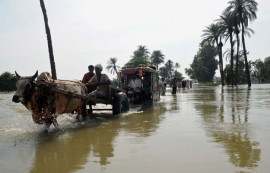
The world’s rivers are in crisis, and the drivers of river degradation are numerous. While pollution in its many forms impairs the quality of our river waters, dams also impact both water quality and the very functionality of rivers, and of planetary lifecycle processes. Roughly two-thirds of the world's rivers have suffered harm from the 50,000 large dams that have been built over the past century. Many of the world's great rivers, such as the Indus, the Colorado and the Yellow Rivers, no longer reach the ocean, turning once productive deltas into deserts.
Healthy, flowing rivers are the lifelines of our planet. They provide people with water, food, medicines, building materials, land-replenishing silts, navigation, recreation, and cultural and spiritual strength. Rivers and their catchments, and the rich variety of life they sustain reduce the impacts of floods and droughts, support forests, recharge groundwater supplies, sustain fisheries and maintain the ecological integrity of local ecosystems. For instance, the river’s estuary, where fresh water mixes with the ocean saltwater, is one of the most biologically productive parts of the river and of the planet.
Rivers and riverine ecosystems are also one of the most threatened in the world. Historically, key stressors have included the over-extraction of water, pollution, diversions and channelisation. In the past 50 years, the amount of run-off flowing into rivers has changed substantially in many basins due to the combined effects of withdrawals, dams and climate change. Traditionally, rivers have been the main source of food, water and primary livelihoods like fishing, flood plain farming, etc. Later, rivers came to be used for navigation purposes, power generation, canal irrigation, industries, tourism etc., increasing the diversity and complexity of river use over the years. Rivers have also been the cultural and religious meeting places for many communities.
Out of all the different human interventions, dams have been the direct and often irreversible modifiers of river flows. The World Commission on Dams has estimated that around 47,000 dams of more than 15-metre height had been built all over the world by the year 2000. About half of the world’s large dams were built primarily for irrigation. However, of all the human interventions on river systems, dams have been the most significant, often irreversible and direct modifiers of river flows, at the cost of the ecological health and ecosystem services of such river systems. Globally, over half of the 292 large river systems are affected by dams. Presently, the number of dams blocking our rivers has crossed 50,000.
Among all the environmental changes wrought by dam construction and operation, the alteration of natural flow regimes has the most pervasive and damaging effects on river ecosystems. Dams can heavily modify the amount of water flowing through the river. Once dammed, the river is at the mercy of the dam operator and the river loses its natural flow pattern. The operation of a hydropower dam can operate at either its peak or at its base load and can fluctuate between the two states on a daily basis. The operation pattern of the power station henceforth decides the timing, frequency and duration of high and low flows, and alters the natural rates at which rivers rise and fall during run-off events. Dams and diversion of water are capable of affecting several kilometres of downstream ecosystems, depending on the size and design of the structure, and the dynamism of the river, thus fragmenting rivers into static reservoirs and channels.
A flowing river is indeed one of the most important and beautiful natural entities on earth. A river is the only ecosystem that connects other ecosystems, carries water, and transports dissolved minerals, sediments and nutrients to maximum places before emptying into its natural outlet. How much water flows through a river channel and the sediment and nutrient load carried by a river is decided by the nature of the catchment and the rainfall or snowfall pattern. Flowing rivers connect different ecosystems like glaciers, forests, riparian zones, flood plains, mangroves, etc. on their way. They also create flood plains, sand deposits, deltas, etc. Rivers, while draining the land, carry out groundwater recharge by percolating into deeper aquifers.
Take the case of the Indus River basin. Originating from the Himalayas, the Indus flows 2,900 kilometres through four countries (China, India, Afghanistan and Pakistan) before it drains into the Arabian Sea. The Indus delta covers an area of some 5,000 square kilometres, of which 2,000 square kilometres is protected area. The fan-shaped delta is the fifth largest in the world and supports a large population, whose livelihood is directly or indirectly dependent on the Indus River. The delta is rich in mangroves, which provides habitat for fish and shrimp and together with the tidal mudflats, supports a rich variety of flora and fauna, and are particularly important as resting and feeding grounds for migratory birds. From a biodiversity perspective also, the delta is important, with 10 species of mammals, 143 species of birds, 22 species of reptiles, over 200 species of fishes, many invertebrate species, including 15 species of shrimp found here. The Indus River is also home to one of the few species of freshwater dolphin, Platanista minor, and to the fishing cat. At least 84 per cent of people living in the delta comprise fishing communities, which catch an estimated 247,000 million tonnes of fish per annum.
Due to heavy abstraction and diversions, the amount of water in the Indus River has decreased dramatically. Little freshwater now reaches the lower Indus. As a result of the reduced flow into the fertile Indus delta, the extent of mangrove forest and biodiversity has declined, shrimp and fisheries reproduction has been reduced due to change in seasonal water availability and modified water quality, and agricultural chemicals have accumulated in the soil. Increased salinisation of the lower Indus has resulted in a decline of fish species, which are sensitive to changes in temperature and salinity. Also, saline water has intruded 64 kilometres inland, because of which acres and acres of farmland have been lost. The loss of delta has led to a decline in the potential of fisheries by 70 per cent. Climate change, if factored into the problems, will worsen the state of the river unless steps are taken to mitigate its impact.
Published in The Express Tribune, March 14th, 2015.
Like Opinion & Editorial on Facebook, follow @ETOpEd on Twitter to receive all updates on all our daily pieces.












































COMMENTS (2)
Comments are moderated and generally will be posted if they are on-topic and not abusive.
For more information, please see our Comments FAQ